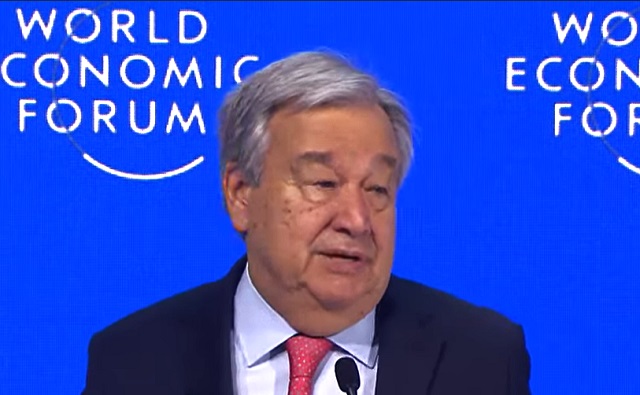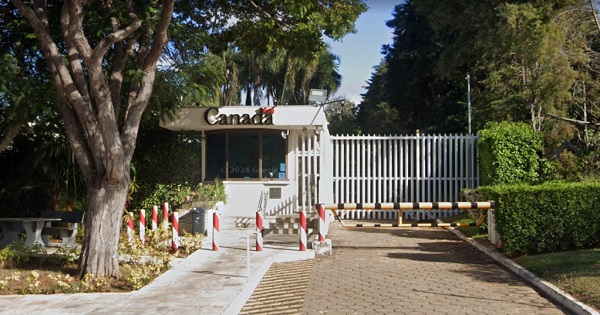espionage
Beijing’s Secret Biowar: National Security Experts Probe Fentanyl and Expanding Viral Bioweapons Program After COVID-19 Lab Leak

A new book argues that Beijing transformed a pandemic lab leak into a global field test — and is now accelerating bioweapons development and fentanyl production from Pakistan to Wuhan.
In 2022, synthetic opioids killed more than 75,000 Americans. But according to the authors of China’s Total War Strategy: Next-Generation Weapons of Mass Destruction, these fentanyl deaths were not simply the result of regulatory failures or a national addiction crisis. They were casualties in a covert biochemical war — one that Western governments remain unwilling to confront. This war, the authors argue, is not waged by rogue actors, but directed by the strategic command of the Chinese Communist Party, wielding an arsenal that includes fentanyl, cognitive warfare, genetically engineered viruses — including the bat coronavirus they say leaked accidentally from Wuhan and was later weaponized through statecraft — and a global criminal underworld mobilized as an instrument of policy.
“This is strategic activity that is driven by hostile state intent,” the authors write, referring to opioid trafficking networks that fuse China’s state-backed chemical supply chains with the industrial-scale production infrastructure of Mexican cartels.
They describe the fentanyl epidemic as “biochemical warfare against a highly clustered group of Western countries” — with the Five Eyes nations as primary targets — and argue that synthetic narcotics can no longer be viewed solely through the lens of organized crime. Instead, they should be understood as instruments in a state-enabled campaign of mass disruption orchestrated by Beijing.
Within the book’s evidentiary framework, China’s alleged fentanyl campaign — paired with the global consequences of the COVID-19 pandemic — emerges as the most consequential demonstration to date of what the authors describe as Beijing’s increasingly effective total war doctrine.
The thesis is unflinchingly dark, confrontational — and, to many readers, will seem conspiratorial. Yet the authors, a team of American national security and military intelligence veterans, construct their case with layers of evidence and the methods of intelligence tradecraft. They connect the Chinese Party-state’s export of fentanyl precursor chemicals and chemical engineering expertise to Mexican cartels, its cognitive warfare operations on Western social media platforms, and its role in the COVID-19 pandemic — forging these seemingly disparate elements into a predictive model of how the Chinese Communist Party is reengineering modern warfare.
This doctrine of clandestine total war, rooted in Chinese military texts, assumes that Beijing — which has signaled intentions to invade Taiwan as early as 2027 — cannot prevail in a conventional conflict against a coalition that may include the United States, Japan, Taiwan, Australia, South Korea, and the United Kingdom. Instead, the strategy prioritizes asymmetric, non-kinetic warfare designed to degrade an adversary’s societal resilience, probe its critical systems, and map its crisis response — all before open conflict begins.
The Bureau is a reader-supported publication.
To receive new posts and support my work, consider becoming a free or paid subscriber.
Cognitive War and Elite Capture
The unfolding shadow war — and the development of next-generation clandestine weapons — is, the authors argue, being waged behind the smokescreen of foreign interference and influence operations. Total War Strategy outlines a multi-track offensive: some elements are deniable yet increasingly brazen and visible, while others remain deeply concealed and poorly understood.
The visible front includes familiar forms of state aggression — industrial espionage, economic coercion, transnational repression, intellectual property theft, election interference, and the covert financing of protest movements. The second, more insidious track, is cognitive warfare: the manipulation of information systems, digital platforms, and social media networks to fracture democratic cohesion and weaken public trust from within. China’s influence operations, according to the authors, serve not merely to shape narratives but to provide cover for far more dangerous strategic objectives.
They cite a pattern of “targeted influence campaigns to undermine, corrupt, persuade and destabilize regimes such as Brazil, Mexico, Canada, Panama, some European Union states and many Sub-Saharan African nations.” These efforts are complemented by sustained economic coercion, intimidation of diaspora communities, trafficking in weapons and narcotics, and the exploitation of academic and technological partnerships — all deployed as tools of indirect warfare.
“Such non-lethal efforts in unsuspecting societies and regimes often succeed,” the authors write, “because feckless leaders are too naive to grasp the insidious assassin’s mace approach.”
In this argument, fentanyl is a primary weapon — and states like Canada remain in denial about their institutional role in enabling the shift of Chinese production and trafficking routes.
Seen through the lens of North America’s fentanyl crisis — in which hundreds of thousands have died while policymakers continue to treat the emergency as a public health or law enforcement issue — the authors argue the Chinese Communist Party is already attacking Western defenses via transnational crime proxies.
“These hostile state extensions are engaged in biochemical warfare against a tightly clustered group of Western countries,” they write. “The effects have been devastating but are fragile and reversible once the massive information asymmetries regarding network structure are rebalanced. The successful collapse of these syndicates in the Five Eyes nations will reduce the likelihood of spread to other countries. The inverse is also true.”
The fentanyl trade, they argue, defies the logic of conventional criminal markets. Unlike heroin or cocaine, synthetic opioids annihilate their own user base. “Fentanyl-laced heroin does not generate a stable population of consumers,” they note, “given the high fatality rates of users.” In a rational market, a drug enterprise seeks to cultivate long-term demand. Fentanyl destroys it. And yet, production and distribution continue to scale exponentially.
Unlike traditional cartels, which can be disrupted through leadership arrests or financial seizures, a state-backed trafficking network is more resilient, adaptive, and strategically dangerous. The CCP’s role — supplying precursor chemicals, trafficking infrastructure, and, in some cases, managerial oversight — elevates the threat from criminal to geopolitical.
That threat, they note, is not evenly distributed. The most devastating effects of synthetic narcotics are concentrated in the Five Eyes intelligence alliance: the United States, Canada, the United Kingdom, Australia, and New Zealand. Europe, despite its liberalized approach to drug markets, has seen no comparable surge in fentanyl fatalities — yet.
COVID-19: Accident Evolves into ‘Field Test’
The authors’ thesis is stark: China’s covert bioweapons program did not merely survive the COVID-19 pandemic — it accelerated, diversified, and deepened in its aftermath.
While much of the world remains fixated on the Wuhan Institute of Virology as the plausible origin point of the COVID-19 crisis, the authors caution that Wuhan was only one node in a vast and opaque network.
Drawing on open-source intelligence, forensic research, and a review of Chinese scientific literature, the authors contend that the Chinese Communist Party has dramatically expanded its clandestine biological weapons program across multiple pathogen types and geographic locations — including, notably, a military-linked facility in Islamabad, Pakistan. Their analysis synthesizes pre- and post-pandemic data, Chinese-language publications, patent filings, and sensitive research documents — some of which disappeared from public access shortly after surfacing.
To build their case, the authors first established a pre-COVID baseline of biological research activity in China, then overlaid post-pandemic developments. What emerges, they argue, is a sprawling, dual-use biological weapons network spanning labs in Wuhan, Harbin, and Beijing — embedded within China’s vast research infrastructure and operated under both civilian and military auspices. Their findings surpass what has been publicly disclosed by Western governments, though they align with intelligence assessments from the United Kingdom, Germany, the FBI, and now the CIA.
According to the authors, the original SARS-CoV-2 outbreak was the result of an accidental lab leak at the Wuhan Institute of Virology in late 2019. They tie the incident to a long-documented pattern of high-risk bat coronavirus gain-of-function experiments conducted at the institute — many of which, they argue, fall within the broader scope of the People’s Liberation Army’s biological warfare program. That program, they assert, enjoys top-level political and military protection from Major General Chen Wei — a senior figure in the CCP’s elite scientific apparatus — whose subordinates have collaborated freely with researchers in Canada and the United States under the guise of pandemic preparedness.
This claim aligns with intelligence findings from CSIS, Canada’s national security agency, and several of its Five Eyes counterparts. But the authors go further: they assert that rather than responding transparently to the accidental lab leak in Wuhan, the Chinese regime quickly adapted — transforming a domestic crisis into a global strategic opportunity.
According to their analysis, CCP-linked intelligence services closely monitored how other nations — including the United States and its allies — responded to the pandemic across public health, economic, and defense sectors. This real-time surveillance, the authors suggest, turned COVID-19 into a de facto field test: a live demonstration of how resilient the West would be in the face of sudden, high-impact biological disruption — and how such disruption could be exploited.
Crucially, they stress that China’s bioweapons research is not limited to coronaviruses. On the far more dangerous end of the threat spectrum, they say, the CCP is pursuing weaponization of high-fatality pathogens such as Nipah virus and African swine fever. Even within the SARS-CoV-2 family, the work continues. One January 2024 study, cited by the authors, describes a new synthetic variant engineered at the Beijing University of Chemical Technology — work they suggest poses even greater risks than the original pandemic strain.
Perhaps most alarming is the convergence they document between genetic engineering and delivery technologies. The CCP, the authors assert, is pairing its pathogen research with advanced nanotechnology platforms — opening the door to next-generation weapons that are more targeted, more concealable, and far more difficult to defend against. Supporting evidence includes experimental data and patent filings that demonstrate efforts to bind engineered viruses with nanoparticles designed for precise delivery.
Even if only portions of the authors’ findings and predictions prove accurate, the book’s well-supported claims suggest that governments — from Washington to Taipei, Berlin, Ottawa, and Canberra — should be urgently educating their populations about the realities of hybrid warfare campaigns waged by Beijing and other hostile states. At a minimum, they should be intensifying preparations for the plausible — if nightmarish — scenarios that Total War Strategy outlines.
With millions already dead since 2020 from the bat coronavirus pandemic and the fentanyl epidemic — both of which, even the most cautious experts acknowledge, trace back to Chinese sources, whether intentionally produced or not — anything less than a serious, studied response to the theory and evidence presented in Total War Strategy would constitute a dangerous dereliction of duty.
Authors Dr. Ryan Clarke, LJ Eads, Dr. Robert McCreight, and Dr. Xiaoxu Lin are national security experts with diverse government and professional backgrounds, and co-founders of the CCP BioThreats Initiative.
espionage
U.S. Charges Three More Chinese Scholars in Wuhan Bio-Smuggling Case, Citing Pattern of Foreign Exploitation in American Research Labs

Federal prosecutors allege visiting researchers at the University of Michigan’s “Xu Lab” conspired to import undeclared biological materials from Wuhan.
Federal prosecutors have charged three additional Chinese research scholars connected to the so-called “Xu Lab” at the University of Michigan with conspiring to smuggle biological materials from Wuhan and making false statements — the latest in a string of national security cases involving suspicious research activity at the university’s Life Sciences Institute.
Named in a newly filed criminal complaint are Xu Bai, 28, and Fengfan Zhang, 27, who face conspiracy counts, and Zhiyong Zhang, 30, who is accused of making false statements. All three held student exchange visas and worked in the lab of Xianzhong “Shawn” Xu, according to the Justice Department. Chengxuan Han, a Chinese citizen who also worked in Xu’s lab, previously pleaded no contest in the related roundworm smuggling case.
According to the complaint, in 2024 and 2025 Bai and Fengfan Zhang received multiple shipments containing concealed biological materials related to roundworms that had been sent from China by Han, a doctoral student at Huazhong University of Science and Technology in Wuhan. The case accelerated when Han traveled to work in the Xu Lab in June 2025. She was questioned at the border and allegedly evaded searches by wiping her phone and concealing biological material.
“At some point, pattern becomes practice. And, apparently, these three men are part of a long and alarming pattern of criminal activities committed by Chinese nationals under the cover of the University of Michigan,” U.S. Attorney Jerome F. Gorgon Jr. said. “This is a threat to our collective security.”
As the Federal Bureau of Investigation counterintelligence case takes shape, the alleged facts resemble a much more serious episode that occurred before the COVID-19 pandemic at Canada’s most secure pathogen research lab in Winnipeg. In that case, according to Canadian intelligence reports, Chinese international students working under Chinese Canadian scientist Xiangguo Qiu were found to be clandestinely importing and exporting biological materials and secretly using the high-security facility for research connected to People’s Liberation Army biological weapons and vaccine programs, including Ebola and bat filovirus studies at the Wuhan Institute of Virology.
Earlier this year, the Justice Department accused two other China-linked researchers, Zunyong Liu and Yunqing Jian, of smuggling Fusarium graminearum — a crop pathogen cited in scientific literature as a potential agricultural terror agent — into the United States for University of Michigan-related research. Their communications referenced shipping biological materials and research plans. Both face smuggling and related charges.
In the new Michigan case, prosecutors allege multiple packages of concealed biological material related to nematode roundworms were shipped from China in 2024 and 2025 by a doctoral student in Wuhan and received by University of Michigan-affiliated scholars. The Justice Department says Han, the prior shipper, pleaded no contest to smuggling and false statement charges this summer before being removed from the United States.
After Han’s removal and an internal university probe into the Xu Lab, the three defendants were terminated for refusing to attend a mandatory meeting, according to the indictment. Investigators say the men then bought tickets to leave from Detroit on Oct. 20, rebooked for Oct. 15, and ultimately attempted to fly out of John F. Kennedy International Airport at 2 a.m. on Oct. 16. During a customs inspection, one defendant allegedly made false statements about Han, while two others admitted receiving packages from her, including after her arrest.
Shawn Xu, who runs the X.Z. Shawn Xu Laboratory, is not charged. From Ann Arbor, Michigan Live reported that federal investigators have not searched Xu, according to his attorney David Nacht.
Xu “has lived in the United States for decades,” Nacht told Michigan Live, adding that Xu studies worms sourced domestically that are not used for commercial purposes.
In the earlier case, Han admitted sending concealed biological materials to University of Michigan recipients. Although the materials were not considered harmful, prosecutors said the shipments violated import and labeling laws.
A Justice Department press release attributed sharp warnings to senior officials about the misuse of academic pathways. “Educational institutions must enhance their admissions procedures to prevent exploitation,” an acting Immigration and Customs Enforcement director said.
“The Chinese nationals charged allegedly were involved in smuggling biological materials into the U.S. on several occasions,” FBI director Kash Patel said. “The FBI and our partners are committed to defending the homeland and stopping any illegal smuggling into our country.”
The Bureau is a reader-supported publication.
To receive new posts and support my work, consider becoming a free or paid subscriber.
Censorship Industrial Complex
How the UK and Canada Are Leading the West’s Descent into Digital Authoritarianism

“Big Brother is watching you.” These chilling words from George Orwell’s dystopian masterpiece, 1984, no longer read as fiction but are becoming a bleak reality in the UK and Canada—where digital dystopian measures are unravelling the fabric of freedom in two of the West’s oldest democracies.
Under the guise of safety and innovation, the UK and Canada are deploying invasive tools that undermine privacy, stifle free expression, and foster a culture of self-censorship. Both nations are exporting their digital control frameworks through the Five Eyes alliance, a covert intelligence-sharing network uniting the UK, Canada, US, Australia, and New Zealand, established during the Cold War. Simultaneously, their alignment with the United Nations’ Agenda 2030, particularly Sustainable Development Goal (SDG) 16.9—which mandates universal legal identity by 2030—supports a global policy for digital IDs, such as the UK’s proposed Brit Card and Canada’s Digital Identity Program, which funnel personal data into centralized systems under the pretext of “efficiency and inclusion.” By championing expansive digital regulations, such as the UK’s Online Safety Act and Canada’s pending Bill C-8, which prioritize state-defined “safety” over individual liberties, both nations are not just embracing digital authoritarianism—they’re accelerating the West’s descent into it.
The UK’s digital dragnet
The United Kingdom has long positioned itself as a global leader in surveillance. The British spy agency, Government Communications Headquarters (GCHQ), runs the formerly-secret mass surveillance programme, code-named Tempora, operational since 2011, which intercepts and stores vast amounts of global internet and phone traffic by tapping into transatlantic fibre-optic cables. Knowledge of its existence only came about in 2013, thanks to the bombshell documents leaked by the former National Security Agency (NSA) intelligence contractor and whistleblower, Edward Snowden. “It’s not just a US problem. The UK has a huge dog in this fight,” Snowden told the Guardian in a June 2013 report. “They [GCHQ] are worse than the US.”
Following that, is the Investigatory Powers Act (IPA) 2016, also dubbed the “Snooper’s Charter,” which mandates that internet service providers store users’ browsing histories, emails, texts, and phone calls for up to a year. Government agencies, including police and intelligence services (like MI5, MI6, and GCHQ) can access this data without a warrant in many cases, enabling bulk collection of communications metadata. This has been criticized for enabling mass surveillance on a scale that invades everyday privacy.
Recent expansions under the Online Safety Act (OSA) further empower authorities to demand backdoors in encrypted apps like WhatsApp, potentially scanning private messages for vaguely defined “harmful” content—a move critics like Big Brother Watch, a privacy advocacy group, decry as a gateway to mass surveillance. The OSA, which received Royal Assent on October 26, 2023, represents a sprawling piece of legislation by the UK government to regulate online content and “protect” users, particularly children, from “illegal and harmful material.” Implemented in phases by Ofcom, the UK’s communications watchdog, it imposes duties on a vast array of internet services, including social media, search engines, messaging apps, gaming platforms, and sites with user-generated content forcing compliance through risk assessments and hefty fines. By July 2025, the OSA was considered “fully in force” for most major provisions. This sweeping regime, aligned with global surveillance trends via Agenda 2030’s push for digital control, threatens to entrench a state-sanctioned digital dragnet, prioritizing “safety” over fundamental freedoms.
Elon Musk’s platform X has warned that the act risks “seriously infringing” on free speech, with the threat of fines up to £18 million or 10% of global annual turnover for non-compliance, encouraging platforms to censor legitimate content to avoid punishment. Musk took to X to express his personal view on the act’s true purpose: “suppression of the people.”

In late September, Imgur (an image-hosting platform popular for memes and shared media) made the decision to block UK users rather than comply with the OSA’s stringent regulations. This underscores the chilling effect such laws can have on digital freedom.
The act’s stated purpose is to make the UK “the safest place in the world to be online.” However, critics argue it’s a brazen power grab by the UK government to increase censorship and surveillance, all the while masquerading as a noble crusade to “protect” users.
Another pivotal development is the Data (Use and Access) Act 2025 (DUAA), which received Royal Assent in June. This wide-ranging legislation streamlines data protection rules to boost economic growth and public services but at the cost of privacy safeguards. It allows broader data sharing among government agencies and private entities, including for AI-driven analytics. For instance, it enables “smart data schemes” where personal information from banking, energy, and telecom sectors can be accessed more easily, seemingly for consumer benefits like personalized services—but raising fears of unchecked profiling.
Cybersecurity enhancements further expand the UK’s pervasive surveillance measures. The forthcoming Cyber Security and Resilience Bill, announced in the July 2024 King’s Speech and slated for introduction by year’s end, expands the Network and Information Systems (NIS) Regulations to critical infrastructure, mandating real-time threat reporting and government access to systems. This builds on existing tools like facial recognition technology, deployed extensively in public spaces. In 2025, trials in cities like London have integrated AI cameras that scan crowds in real-time, linking to national databases for instant identification—evoking a biometric police state.

Source: BBC News
The New York Times reported: “British authorities have also recently expanded oversight of online speech, tried weakening encryption and experimented with artificial intelligence to review asylum claims. The actions, which have accelerated under Prime Minister Keir Starmer with the goal of addressing societal problems, add up to one of the most sweeping embraces of digital surveillance and internet regulation by a Western democracy.”
Compounding this, UK police arrest over 30 people a day for “offensive” tweets and online messages, per The Times, often under vague laws, fuelling justifiable fears of Orwell’s thought police.
Yet, of all the UK’s digital dystopian measures, none has ignited greater fury than Prime Minister Starmer’s mandatory “Brit Card” digital ID—a smartphone-based system effectively turning every citizen into a tracked entity.
First announced on September 4, as a tool to “tackle illegal immigration and strengthen border security,” but rapidly the Brit Card’s scope ballooned through function-creep to envelop everyday essentials like welfare, banking and public access. These IDs, stored on smartphones containing sensitive data like photos, names, dates of birth, nationalities, and residency status, are sold “as the front door to all kinds of everyday tasks,” a vision championed by the Tony Blair Institute for Global Change— and echoed by Work and Pensions Secretary Liz Kendall MP in her October 13 parliamentary speech.
Source: TheBritishIntel
This digital shackles system has sparked fierce resistance across the UK. A scathing letter, led by independent MP Rupert Lowe and endorsed by nearly 40 MPs from diverse parties, denounces the government’s proposed mandatory “Brit Card” digital ID as “dangerous, intrusive, and profoundly un-British.” Conservative MP David Davis issued a stark warning, declaring that such systems “are profoundly dangerous to the privacy and fundamental freedoms of the British people.” On X, Davis amplified his critique, citing a £14m fine imposed on Capita after hackers breached pension savers’ personal data, writing: “This is another perfect example of why the government’s digital ID cards are a terrible idea.” By early October, a petition opposing the proposal had garnered over 2.8 million signatures, reflecting widespread public outcry. The government, however, dismissed these objections, stating, “We will introduce a digital ID within this Parliament to address illegal migration, streamline access to government services, and improve efficiency. We will consult on details soon.”
Canada’s surveillance surge
Across the Atlantic, Canada’s surveillance surge under Prime Minister Mark Carney—former Bank of England head and World Economic Forum board member—mirrors the UK’s dystopian trajectory. Carney, with his globalist agenda, has overseen a slew of bills that prioritize “security” over sovereignty. Take Bill C-2, An Act to amend the Customs Act, introduced June 17, 2025, which enables warrantless data access at borders and sharing with U.S. authorities via CLOUD Act (Clarifying Lawful Overseas Use of Data Act) pacts—essentially handing Canadian citizens’ digital lives to foreign powers. Despite public backlash prompting proposed amendments in October, its core—enhanced monitoring of transactions and exports—remains ripe for abuse.
Complementing this, Bill C-8, first introduced June 18, 2025, amends the Telecommunications Act to impose cybersecurity mandates on critical sectors like telecoms and finance. It empowers the government to issue secret orders compelling companies to install backdoors or weaken encryption, potentially compromising user security. These orders can mandate the cutoff of internet and telephone services to specified individuals without the need for a warrant or judicial oversight, under the vague premise of securing the system against “any threat.”
Opposition to this bill has been fierce. In a parliamentary speech Canada’s Conservative MP Matt Strauss, decried the bill’s sections 15.1 and 15.2 as granting “unprecedented, incredible power” to the government. He warned of a future where individuals could be digitally exiled—cut off from email, banking, and work—without explanation or recourse, likening it to a “digital gulag.”
Source: Video shared by Andrew Bridgen
The Canadian Constitution Foundation (CCF) and privacy advocates have echoed these concerns, arguing that the bill’s ambiguous language and lack of due process violate fundamental Charter rights, including freedom of expression, liberty, and protection against unreasonable search and seizure.
Bill C-8 complements the Online Harms Act (Bill C-63), first introduced in February 2024, which demanded platforms purge content like child exploitation and hate speech within 24 hours, risking censorship with vague “harmful” definitions. Inspired by the UK’s OSA and EU’s Digital Services Act (DSA), C-63 collapsed amid fierce backlash for its potential to enable censorship, infringe on free speech, and lack of due process. The CCF and Pierre Poilievre, calling it “woke authoritarianism,” led a 2024 petition with 100,000 signatures. It died during Parliament’s January 2025 prorogation after Justin Trudeau’s resignation.
These bills build on an alarming precedent: during the COVID era, Canada’s Public Health Agency admitted to tracking 33 million devices during lockdown—nearly the entire population—under the pretext of public health, a blatant violation exposed only through persistent scrutiny. The Communications Security Establishment (CSE), empowered by the longstanding Bill C-59, continues bulk metadata collection, often without adequate oversight. These measures are not isolated; they stem from a deeper rot, where pandemic-era controls have been normalized into everyday policy.
Canada’s Digital Identity Program, touted as a “convenient” tool for seamless access to government services, emulates the UK’s Brit Card and aligns with UN Agenda 2030’s SDG 16.9. It remains in active development and piloting phases, with full national rollout projected for 2027–2028.
“The price of freedom is eternal vigilance.” Orwell’s 1984 warns we must urgently resist this descent into digital authoritarianism—through petitions, protests, and demands for transparency—before a Western Great Firewall is erected, replicating China’s stranglehold that polices every keystroke and thought.
If you find value in the work I do, please consider a paid subscription or make a one-off donation.
-

 Justice2 days ago
Justice2 days agoCarney government lets Supreme Court decision stand despite outrage over child porn ruling
-

 COVID-192 days ago
COVID-192 days agoFreedom Convoy leader Tamara Lich to appeal her recent conviction
-

 Daily Caller2 days ago
Daily Caller2 days agoUN Chief Rages Against Dying Of Climate Alarm Light
-

 Business2 days ago
Business2 days agoCarney’s budget spares tax status of Canadian churches, pro-life groups after backlash
-

 Business2 days ago
Business2 days agoU.S. Supreme Court frosty on Trump’s tariff power as world watches
-

 Business22 hours ago
Business22 hours agoCarney budget continues misguided ‘Build Canada Homes’ approach
-

 espionage1 day ago
espionage1 day agoU.S. Charges Three More Chinese Scholars in Wuhan Bio-Smuggling Case, Citing Pattern of Foreign Exploitation in American Research Labs
-

 Business23 hours ago
Business23 hours agoCarney budget doubles down on Trudeau-era policies














